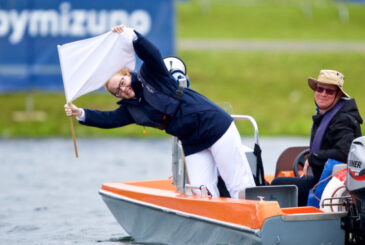We continue this series of articles on the application of the Rules of Racing and their significance to the rowing community with a visit to Control Commission
Umpires tend to have their favourite roles: the start-line is always exciting, and following six or eight lanes down Dorney, Nottingham or Strathclyde in a launch, desperately trying to keep crews in the right place, is challenging. But Control Commission is enjoyable as it’s the best opportunity to interact with the crews.
Contrary to popular belief, there is no prize for the umpire who manages to snap the most heel restraints and we don’t enjoy stopping crews from racing; however the underlying aim of all umpires is to provide safe, fair and equal racing (Rule 1-2 of the British Rowing Rules of Racing).
And Control Commission is, for the most part, where this happens.
We want to make sure that crews going afloat have safe equipment. At all events, safety is still critical but at Control Commission elements of fairness can also begin to enter into the equation as well.
I have seen an international level crew in a brand-new expensive German eight without the heel restraints attached!
The duties of the Control Commission are set out in Rule 7-2-2. We supervise the crew boating areas to check that all relevant rules pertaining to crew composition and equipment are being observed.
It remains the responsibility of each crew to ensure that they abide by the rules about crew composition and equipment. It is not the role of the Control Commission to check everything and we carry out spot-checks to ensure that the rules are being observed.
It varies by event as to how many crews are checked and, at top-level events, crew composition, weight, cox weight etc will all be checked. At local events, especially involving juniors, we tend to be more interested in equipment safety. I have, however, seen an international level crew in a brand-new expensive German eight without the heel restraints attached!
We like asking juniors what they have checked about the boat themselves, as it gets them into the safety mindset
As a rule of thumb I like to operate a 1/3, 1/3, 1/3 system. That is I thoroughly check one third of boats passing through, ask the crew and the cox (if there is one) of one third whether they have checked their boat, and what they have checked, and let a third go unchecked. There is obviously a random element about this, but if a crew turns up with a shabby looking boat with the bits hanging off it they are more likely to get pulled over for a check.
We particularly like asking juniors what they have checked about the boat themselves, as it gets them into the safety mindset and thinking about checking the boat. It’s good racing practice for a crew to check the boat before and, perhaps it is because of this, that umpires on Control Commission might look a little disheartened when a boat that obviously has not been checked is presented to them.
I had a particularly amusing conversation with some juniors who presented a boat that was perfectly safe, but which had no seats in it. This was not a safety issue but it would have made life a little difficult for them and certainly would have caused a delay (for them and others) on the boating raft when they eventually realised!
The standard gripe is of course heel restraints. This is a prime safety issue and if they are either not there, not attached, too loose or completely frayed, then crews will be sent away to rectify them.
The other safety issue that we find regularly is small coxes wearing large life jackets that would just float over their heads if they fell out of the boat.
Control Commission also checks on fairness. Random checks are made on crew composition as it is cheating to enter events with higher ranked rowers in the crew. Most of the occasions when I’ve seen this, it has been more cock-up than conspiracy – a last-minute substitution where BROE hasn’t been updated. Similarly, we will check that coxes and lightweights have their appropriate slips.
But mainly we just like chatting to the crews – so please be nice to us.
Next Secret Umpire article: Unsportsmanlike behaviour >>
Find out more about umpiring
Have you considered umpiring?
We are always looking for new recruits to replace those who step down. You can still umpire and race/coach at the same time, as many of our community still do. The minimum requirement is just three separate days and 12 hours per year.
If you are interested, then please contact the National Umpiring Committee. We will then direct you to your regional umpiring committee for training.
You will be warmly welcomed!










